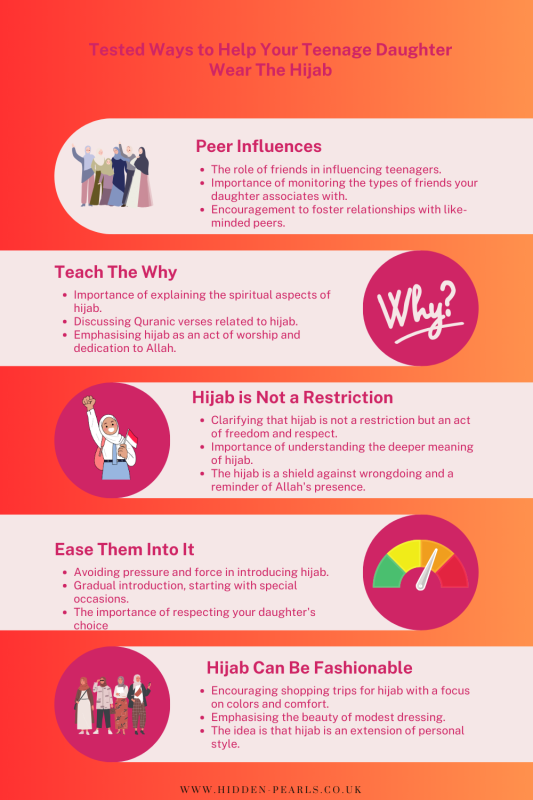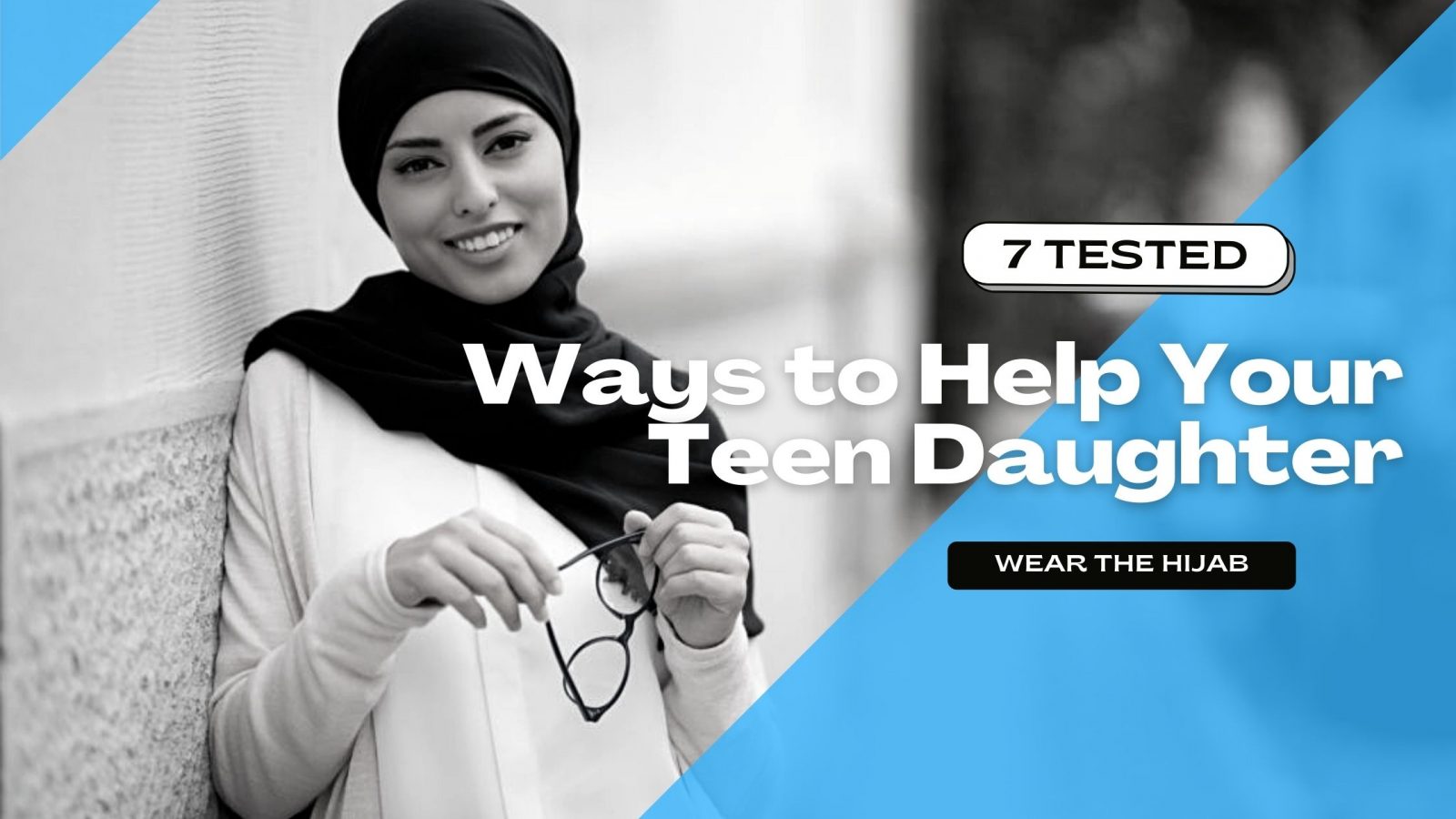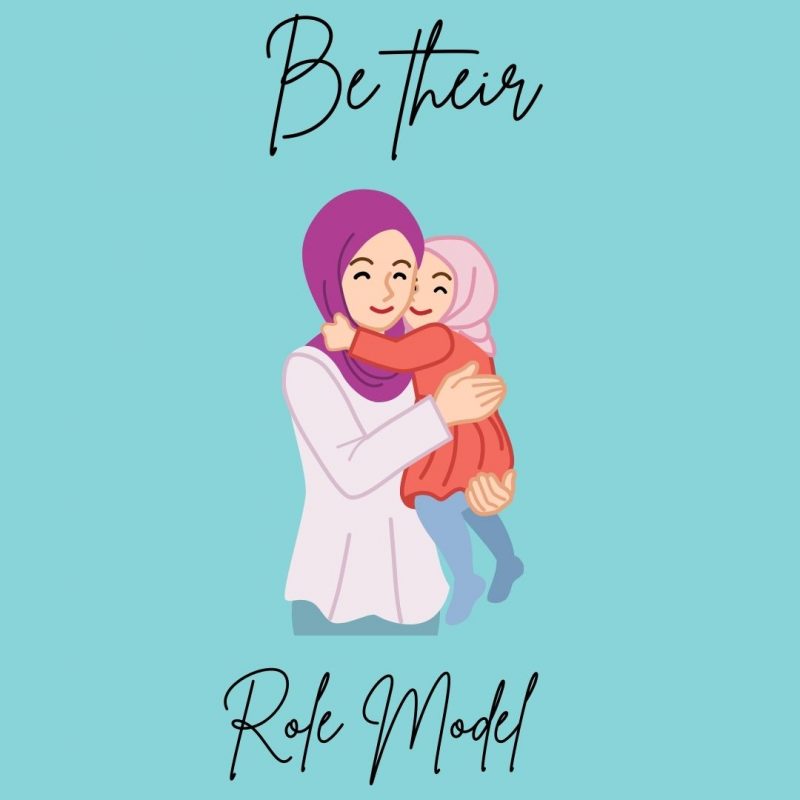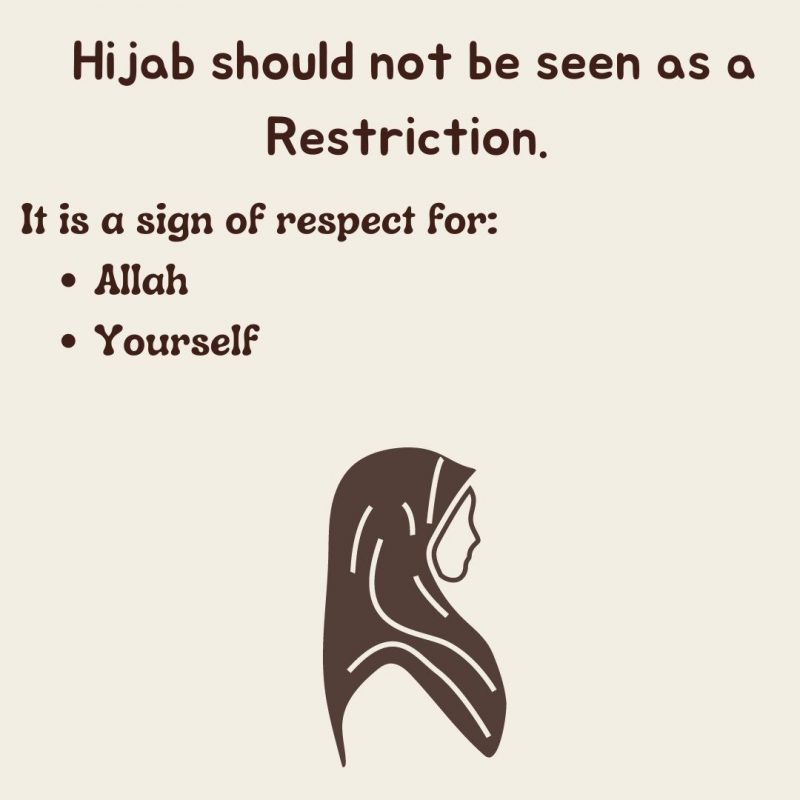The Hijab Diaries
7 Tested Ways to Help Your Teenage Daughter Wear The Hijab
Assisting your teenage daughter in embracing the hijab doesn’t need to be an overwhelming challenge. As girls swiftly transition into adolescence, the desire for independence and freedom becomes more apparent. Some may resist wearing the hijab, presenting common arguments like “Why is it necessary? None of my friends wear it!” or “I should have the freedom to choose my clothing.” Many mothers find these sentiments familiar and relatable.
Sadly more and more parents seem to be losing the argument in today’s world. It is really hard to convince a teenager to wear a hijab. That’s why we will be giving you these 7 tips today in helping your daughters wear the hijab. These are tried and tested methods by parents. Some of the stuff we will talk about has been ordained by Allah (SWT). However, we often forget that it is these small things that can make a huge impact. Instead of focusing on forcing or pushing the hijab, try and build your child’s future with these methods so that wearing the hijab becomes naturally ingrained. You can start by looking at the range of hijabs we have alongside underscarves and pins.
Contents
Early Introduction to Hijab
Introducing the hijab to our daughters from an early age aligns with the teachings of Islam. The Quran and Hadith emphasize modesty and prescribe the hijab as a symbol of piety. Instilling this practice in childhood lays a foundation for a deep connection with Allah and the understanding of its significance in later years. As parents, guiding our daughters in adorning the hijab becomes a reflection of nurturing Islamic values within our homes.
It is important to understand that a child is not held accountable until the signs of puberty come about. As the Prophet (PBUH)) said, “The Pen has been lifted from three: from the child until he reaches puberty, from the sleeper until he wakes up, and from the one who has lost his mind until he recovers.” ( (Narrated by Abu Dawud, 4402).
In the context of Islam, once puberty is attained, the obligation to wear the hijab is established for both boys and girls. The shared signs of puberty include nocturnal emissions (wet dreams), the growth of coarse hair around private parts, and reaching the age of fifteen.
For females, a distinctive fourth sign is the onset of menstruation, marking the transition into the age of accountability. However, it is important to remember that you cannot wait till they are that age to start getting them to wear the hijab or to fulfill their religious obligations. Children should be taught from a young age about Islam and the importance of Salah, Hijab, Obedience to Allah (SWT).
This should be done via using positive reinforcement and using positive language e.g. words like “beautiful,” “special,” and “honorable” to describe the hijab, fostering positive associations in their mind. It would also be a good idea to utilize stories, videos, or illustrations that portray hijab in a positive light.
Wives of the Prophet
Aishah narrated that the wives of the Prophet (peace and blessings of Allah be upon him) used to go out at night to al-Manasi’ (well-known places in the direction of al-Baqi’) to relieve themselves and ‘Umar used to say to the Prophet (peace and blessings of Allah be upon him), “Let your wives be veiled.” But the Messenger of Allah (peace and blessings of Allah be upon him) did not do that. Then one-night Sawdah bint Zam’ah, the wife of the Prophet (peace and blessings of Allah be upon him), went out at ‘Isha time and she was a tall woman. ‘Umar called out to her: “We have recognized you, O Sawdah!” hoping that the hijab would be revealed, then Allah revealed the verse of hijab. (Narrated by al-Bukhari, 146; Muslim, 2170)
Mother-Daughter Connection
It is so important to build a mother-daughter connection. A daughter may feel overwhelmed by her mother, if she is always speaking about the benefits of the hijab but not the struggles. We spoke to Sammiya who said she had an open and frank conversation with her daughter.
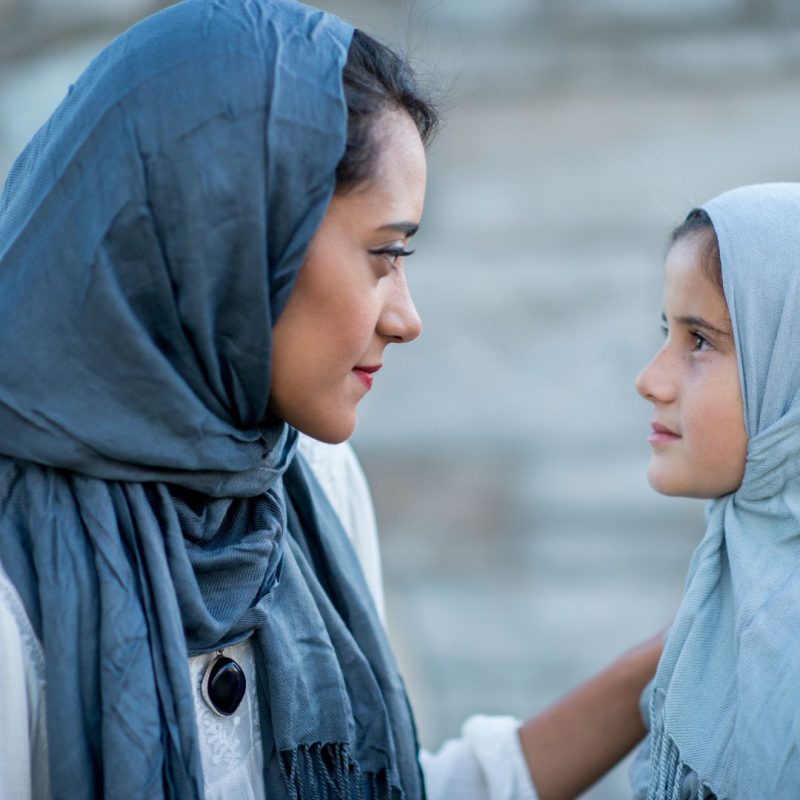
Da’wah
One of the most visible forms of Muslim self-identity is the hijab worn by Muslim women. But taking on this identity comes with its fair share of struggles, especially in the Western world. Many times, it is difficult for even adults to fight through these struggles.
Read all about our Managers hijab story here. So if we as adults go through these problems how can we not expect the same to happen from our daughters who have stepped into a grown-up world. A lot of teenage girls express feelings of not being understood when it comes to wearing a hijab. Along with that they may be weighed down by negative feelings of dread or feeling ugly. We need to start by trying to understand their point of view.
Giving Da’wah to Children
Unfortunately, most parents fail to understand that our children need da’wah too. Just because they are born Muslims, they are expected to automatically show a liking for Islam and its rulings. They too should be approached as one would approach a new Muslim.
This should be done by solidifying their belief in Allah (SWT) and inculcating a deep love for Allah and His Commandments. So where do we start and how soon is too soon? Here are 7 tips to helping teenage daughters wear the hijab.
Avoiding Negative Associations
It is important that within your Da’wah you are helping your child in a way that will benefit them. This includes
- Avoiding Kaffir Clothes – Provide suggestions for age-appropriate Islamic clothing options for young girls, clothes that they can feel confident in. Let them discover their style.
- Involve the family in discussions about the importance of Islamic dress from an early age for both girls and boys so that girls do not feel singled out and they know that boys also have to observe hijab but in a different way.
Positive Comparisons
it is a good idea to spend some time and try to do the following with your daughter:
- Gratitude Practice – Encourage expressing gratitude for the ability to follow Allah’s commandments
- Understanding Differences – Teach tolerance and understanding of diverse perspectives.
7 Tips To Getting Your Daughter To Wear The Hijab
Tip 1: Dua, dua, and more dua to help teenage daughters wear the hijab
And those who say:
‘Our Lord! Bestow on us from our wives and our offspring, the comfort of our eyes, and make us leaders for the muttaqūn .(pious) (Sūrat al- Furqān, 25:74)
Allah (swt) says that parent’s dua for their child will not go unanswered. Make dua regularly, that Allah (swt) grants you and your children a righteous life, giving you the guidance to observe the commandments of Islamic behaviour and dress. Check out the 10 best times to make Dua here. Make the most out of these dua times. Reaching out to Allah is one of the most powerful ways of changing how your daughter thinks.

But along with dua be patient with her. Maybe she does not yet understand the importance of the hijab and needs more encouragement to wear it. Remind her gently of the benefits of wearing the hijab. Don’t get angry and shout or scream at her.
If you can, try to begin the journey and the duas whilst the child is at a young age, as if you leave it until they turn 10+, it can be very difficult to make them understand why they need to be wearing the hijab.
Tip 2: Be the role model you wish them to follow.
In a world where your daughter is surrounded by pop stars and actors as teen icons, it is very important that she has Muslim role models to look up to. A mother is the first influential person in a child’s life, one she is most likely to imitate consciously and unconsciously. Your love (or hate) relationship with hijab will be obvious to your daughter so be wary of this. A mother of a teenage daughter shares her experience:
As soon as my daughter approached me about wearing a hijab, I had to remind her that wearing a hijab at such a young age is not obligatory, for it is only fard once a female reaches puberty. However, my daughter still insisted in wearing the hijab because her “mommy wears one.” That’s when I realised that my daughter noticed me wearing a hijab every time I left the home, and therefore, she mentally noted that mom wears a hijab when out in public, and wanted to imitate me in that manner.
As parent’s, it is our responsibility to ensure that hijab is adhered to:
The guardian should instruct his daughters to wear hijab and make them adhere to it, and the mother should do likewise, because the parents are responsible for their children, and for raising them properly and ensuring that they adhere to obedience to Allah as much as possible.
Your Actions Matter
It is important your daughter learns from your actions. She needs to realise the hijab is an obligation just like praying, just like fasting, just like being good to one’s parents etc.
Helping teenage daughters wear the hijab requires some effort on your part. If she sees you doing all of this, she will also learn to cover herself for the sake of Allah (swt).
It is very important to have open and frank conversations with your daughter. In this day and age, discuss the pros and cons of a hijab. Explain what difficulties you had. This will help her to learn to what extent we are willing to sacrifice for Allah (swt). Don’t make it sound all easy, make her aware of the struggles and then explain how you overcame your struggles. Help her to understand that wearing the hijab in today’s society is akin to jihad. It is an internal battle and one that we need to fight for the sake of Allah (swt).
Tip 3: Peer influences
Helping teenage daughters wear the hijab is a battle. A majority of teens and young adults care deeply and are greatly influenced by what their friends think about them. As a parent, it is vital that you are aware of what kind of people your daughter spends her time with.
We all want to be liked by other people. It’s natural to feel this way. That’s why it is important to ensure that the type of friends your daughter keeps are monitored from an early age. Nonetheless, there are circumstances where your daughter may not have had the right peers around her.
If she does not have friends who practice Islam or cover their heads, you could take her to halaqas, or masjid programs. Here she can meet teenagers and she can make like-minded friends. Encourage her to nurture these relationships. Remember the Prophet (saw) said:
“A man is upon the religion of his best friend, so let one of you look at whom he befriends.” (Reported by Abu Huraira in Sunan Abu Dawud)
Teach your child to be confident in her beliefs. If she has friends who are practising she will have other people to turn to when she is struggling;
Allah’s Messenger (swt)
“The example of a good companion (who sits with you) in comparison with a bad one, is I like that of the musk seller and the blacksmith’s bellows (or furnace); from the first you would either buy musk or enjoy its good smell while the bellows would either burn your clothes or your house, or you get a bad nasty smell thereof.” [Bukhari]
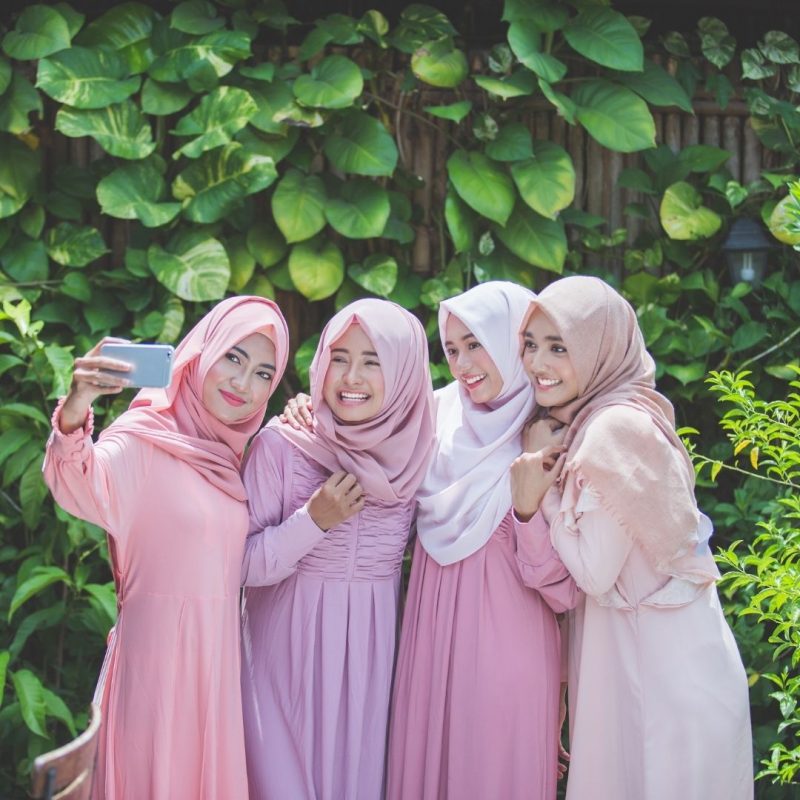
Tip 4: Teach them the ‘why’
Most parents feel it is important for their daughter to wear a hijab, but it is equally important that she knows why she is doing it. Providing her with a washed down version, that she should cover up so as to not tempt men, will not stick for too long.
Their reason for wearing hijab will motivate them to continue wearing it in spite of possible adverse circumstances around them. It will no longer be just a piece of cloth they are required to wear because their parents say so.
If parents strive to convey the spiritual aspects of the hijab to their daughters, it will become and remain a priority throughout their life. And nothing can be more perfect in explaining this to her than through the Word of Allah (swt) the Glorious Quran. Discuss the verses of hijab with her.
Read explanations and commentaries of these verses together. Helping her understand these verses will go a long way in boosting her confidence and willingness to wear the hijab.
Allah says in Surat-ul-Ahzab, “O Prophet! Say to your wives and your daughters and the women of the believers that they let down upon them their over-garments; this will be more proper, that they may know {as believing women}, and thus they will not be annoyed or harassed; And Allah is Forgiving, Most Merciful”
Hijab is not a restriction
Hijab should not be seen as a restriction. Instead, it is an act of freedom and a sign of respect not just for Allah, but also for yourself as well. Often, we limit the understanding of the hijab to it being a piece of fabric that covers us and that it should be worn. No background is given to help understand the reasoning behind it.
Helping teenage daughters wear the hijab requires us to help teenagers understand that the hijab is something that not only reflects proper dressing but also modest behaviour for both men and women. Hijab is a barrier between the girl and the unwanted attention of men.
Help her to understand nobody can physically force anyone in this day to do XYZ. However, when an act is an obligatory act in itself, it’s forced upon us by our creator Allah. Allah has commanded us to pray, fast, Hajj, zakat, wear the hijab, grow the beard, etc. by default it’s an obligation as a Muslim. We just have the free will to disobey Allah’s commands.
Hijab is for Allah
Our thoughts at Hidden Pearl’s towards the hijab has always been simple. It is an act of worship and not as an aspect of worldly nature or for other people.
We don’t just wear hijab when we go outside or are in front of any of our non-mahrams. You need to explain that it is not just worn because men will lower their gaze (though some really sick ones won’t even do it then). It is important she understands that women wear the hijab when we pray. It is also worn to cover ourselves in front of Allah, and this also cements that wearing hijab is more than just for this worldly life, but is a part of our Ibadah.
Helping teenage daughters wear the hijab requires some explanation. It is important that they realise the hijab is showing your dedication to Allah (SWT) and reminds us as Muslim women that we have responsibilities as a Muslim.
Yes, Hijab is how we dress. We ensure we accept Allah’s command. We ensure men do not gaze at us, but we also show how we are carrying ourselves and how we are being represented in the world.
Self-reflection is important. We need to constantly remind ourselves that the hijab is also a shield against wrongdoing. We will think twice before e.g. swearing, or going into a pub.
In most cases, wearing a hijab would help you present yourself in a positive way. Your way of dress is a public reminder of the presence of Allah (SWT). Having said this, It is important to remember, teaching your children mannerisms from a very young age is very important.
Tip 5: Ease them into it, do not pressurise.
Forcing children to do something or getting mad at them for not listening, won’t really work. It may leave them with bad impressions for the rest of their life. The key is in being tactful and patient. Your daughter should feel that it is her choice and not something being enforced against her will. You can start by encouraging her to wear the hijab on special occasions or outings. This will help them adapt to this new dress code gradually.
it would be a good idea to respect her decision but make dua for her and ask Allah to guide her. As a parent, it is our responsibility to explain, encourage and guide children correctly. However, constantly forcing can have repercussions as one sister explains:
My parents forced my older sister to wear a hijab when she wasn’t ready, so she’d leave the house wearing one and take it off wherever she went (uni, mall, etc.), and then she’d put it back on just as she came back home. When my parents found out, they were really hurt and were upset that they were being lied to. They accepted that they can’t force something upon my sister so they told her to be honest, leave the hijab and come back to it when she is ready. It’s been about 6 years now and she’s slowly coming around. Just got to keep making dua for her.
Tip 6: Hijab does not have to be boring
Initially, the hijab will start off as a command, just like prayer or wudhu. But over time, In Shah Allah, she will begin to notice the benefits. The little flickers of happiness within a situation you don’t really understand that snowball into a reason why. The beauty in hijab will show and with it will come peace.
Take shopping trips with your daughter. Let her choose the colours she loves. She can match hijabs with her favourite outfits. Do keep in mind the material though. Help her choose something she is comfortable in. If you don’t have hijab shops in your locality, a lot of online stores offer wonderful options.
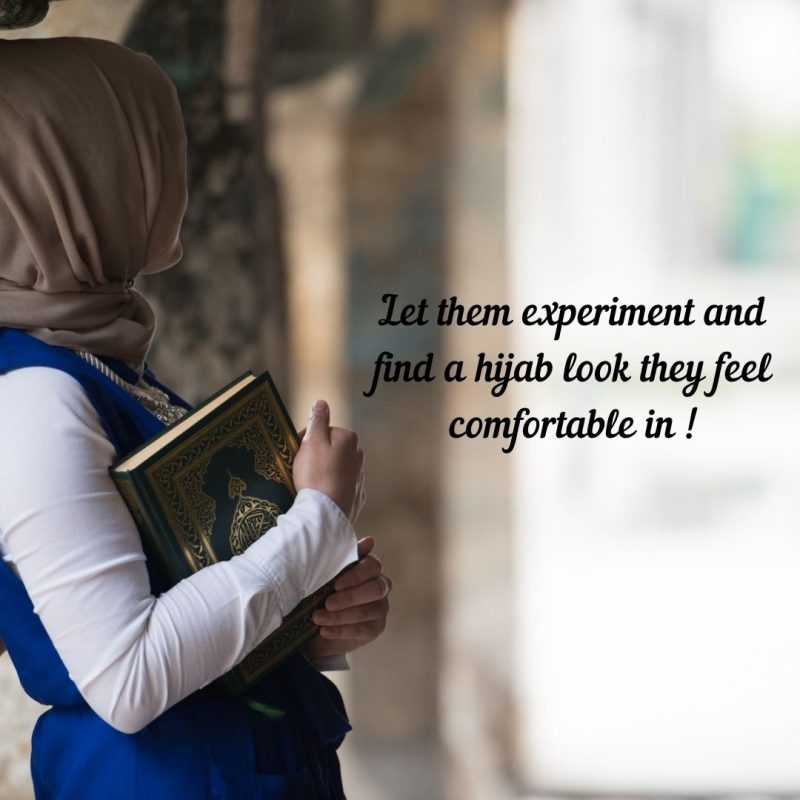
Help her learn the beauty of dressing modestly and covering herself in a world of obscenity. Show her how it sets you apart from the rest. And a hijab isn’t just the headscarf, it’s the entire act of wearing loose clothing to cover yourself. In Islam, the body is sacred. As a result, it is a responsibility on you from Allah (swt). Think of it as being loaned to you. Therefore It is your responsibility to keep it healthy, happy and nourished. So, you eat healthily, you exercise and you dress modestly.
Teenage girls need time to get used to the hijab
Remember to ease her into the hijab gently. Our hijabs are extensions of ourselves. We express ourselves through them via the fabrics we use and the styles we wrap them in. Let her wear her own style, as long as it meets the Islamic criteria of loose and modest.
Prepare her for the questions she will face. She will likely get many people smiling and nodding to her saying Aslam salaam alaikum. Teach her to respond with Walaikum as-salaam. The statement is not religious. It tells the other person that she comes bearing no ill will or harm.
Most importantly, teach her to be on her best behaviour while wearing the hijab. It will show others her integrity, honesty and how pious she is. teach her to treat it with respect. And have fun finding fabrics and pins she adores whilst arming her with the correct knowledge!
Tip 7: It’s not just the girls.
“Say to the believing men that: they should cast down their glances and guard their private parts (by being chaste). This is better for them…(Surah Nur Verse 30)
“Say to the believing women that: they should cast down their glances and guard their private parts (by being chaste) …”(Surah Nur Verse 31)
Helping teenage daughters wear the hijab requires them to understand that the command is not just for girls, but for boys as well.
Allah(swt) tells both, the believing men and women to implement the laws of modesty. Parents need to stress the importance of modesty to the boys too. Teach your boys to lower their gaze and observe modesty in dressing by wearing loose clothing. Have a conversation with them too, on why you wear the hijab. Knowing that the rules are for their brothers too, your daughters will not feel singled out.
On a final note, no matter what, please keep inspiring your daughter by being a good role model and by discussing the virtues of hijab and modest dressing. Tell her about amazing Muslim women who have achieved success in their fields, while maintaining the boundaries of modesty. Choosing to wear a hijab is not just about a dress code, it is about adorning a lifestyle. Let your daughter’s transition be a gradual one. It is a change that can be lasting only if it comes from within.
We really hope our 7 tested ways to help your teenage daughter wear the hijab has given you some sort of framework to work with. Please let us know if you have questions or any useful tips of your own!
